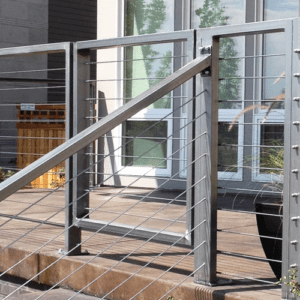
Common Railing Code Violations and How to Avoid Them
Building code compliance is a must when designing or implementing a railing system. In addition to ensuring safety, codes can result in expensive delays, fines, or even the need for a full reinstallation. The most frequent railing code infractions are listed below, along with tips on how to ensure your project stays clear of them.
1. Incorrect Railing Height
The Issue: Railing height requirements are often misunderstood. Commercial and multi-family applications frequently demand for guardrails that are 42 inches tall, whereas residential guardrails must normally be at least 36 inches. Some states, such as California, require a 42-inch rail height even for residential projects, which can catch homeowners and builders off guard.
How to Avoid It: Always verify your local jurisdiction’s minimum height requirement before installation. Measure from the walking surface (deck, landing, or floor) to the top of the handrail or guardrail.
2. Excessive Spacing Between Balusters or Cables
The Issue: Particularly for kids, gaps larger than 4 inches can pose a safety risk. This holds true whether glass panels, horizontal cables, or vertical balusters are being used.
How to Avoid It: Use the “4-inch sphere rule”—no sphere larger than 4 inches should pass through any opening. For cable railing, tension cables properly to prevent deflection that could create wider gaps.
3. Improper Handrail Design or Placement
The Issue: Handrails need to be positioned correctly, be continuous, and be able to be grasped. Using a top rail that is too wide for a firm grasp or not providing a return at the ends are frequent infractions..
How to Avoid It: Choose a handrail profile that satisfies the graspability code, which is usually between 1¼” and 2″. Make sure the handrails extend all the way to the stairway and neatly transition back to a wall or post.
4. Inadequate Structural Strength
The Issue: Railings that are unable to support loads specified by code run the danger of failing. Guardrails must typically withstand 200 pounds of force applied in any direction, according to codes.
How to Avoid It: Make use of strong posts, long-lasting materials, and safe mounting techniques. When necessary, reinforce with blocks, brackets, or core drilling rather than only surface-level fasteners.
5. Overlooking Local Code Variations
The Issue: Local jurisdictions may have more stringent regulations, although national codes (such as the IRC or IBC) offer a starting point. Ignoring these may result in rejection at inspection.
How to Avoid It: Before starting any installation, make sure to verify with the local building department. Verify that a contractor you are working with is current on regional code requirements.
Final Thoughts
Passing inspection is only one aspect of railing code compliance; other considerations include longevity, safety, and peace of mind. You can make sure your railing system is both aesthetically pleasing and safe by being aware of common infractions and taking proactive measures to avoid them.
Contact Us
At Stainless Cable & Railing, we offer railing systems that are made to code while adding strength and style to your area. Our staff is available to assist you with compliance-related inquiries or in choosing the best system for your project.
📞 Call us at (888) 686-7245
✉️ Email us at [email protected]
🌐 Visit us at stainlesscablerailing.com







